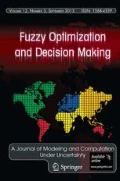Abstract
The SPAN (Successive Proportional Additive Numeration or Social Participatory Allocation Network) is a procedure that converts individual judgments into a group decision. The procedure is based on a voting design by which individual experts allocate their votes iteratively between their preferred options and other experts. The process ends when all the votes are allocated to options, and the one with the highest number of votes is selected. The method requires the experts to specify an exact allocation of votes to both options and other experts. The Fuzzy Linguistic SPAN allows experts to allocate their votes using linguistic labels such as “most of” or “a few”, and determine the preferred option. This method is demonstrated using the Max–Min aggregation function used to develop a proportional representation of the option and member voting schemes. The method is also demonstrated using the LOWA aggregation function. The Fuzzy Linguistic SPAN method is beneficial since the linguistic voting process is easier for the experts and significantly reduces the computational process compared to the traditional SPAN. The paper presents the method and two examples with comparisons to the numerical SPAN method.
Similar content being viewed by others
References
Chen, Shu-Jen, C. L. Hwang, and in collaboration with Frank P. Hwang. (1992). Fuzzy Multiple Attribute Decision Making. New York: Springer-Verlag.
D. Dubois H. Prade (1985) ArticleTitleA Review of Fuzzy Sets Aggregation Connectives Information Science 36 85–121 Occurrence Handle10.1016/0020-0255(85)90027-1
F. Herrera E. Herrera-Viedma J. L. Verdegay (1996) ArticleTitleDirect Approach Processes in Group Decision Making using Linguistic OWA Operators Fuzzy Sets and Systems 79 175–190 Occurrence Handle10.1016/0165-0114(95)00162-X
F. Herrera L. Martinez (2000) ArticleTitleA 2-Tuple Fuzzy Linguistic Representation Model for Computing with Words IEEE Transactions on Fuzzy Systems 8 IssueID6 746–752 Occurrence Handle10.1109/91.890332
F. Herrera E. Herrera-Viedma J. L. Verdegay (1997) ArticleTitleA Rational Consensus Model in Group Decision Making Using Linguistic Assessments Fuzzy Sets and Systems 88 31–49 Occurrence Handle10.1016/S0165-0114(96)00047-4
E. Herrera-Viedma F. Herrera F. Chiclana (2002) ArticleTitleA Consensus Model for Multiperson Decision Making With Different Preference Structures IEEE Transactions on Systems Man and Cybernetics – Part A: Systems and Humans 32 IssueID3 394–402 Occurrence Handle10.1109/TSMCA.2002.802821
His.-Mei Hus (1996) ArticleTitleAggregation of Fuzzy Opinions Under Group Decision Making Fuzzy Sets and Systems 79 279–285 Occurrence HandleMR1388402
C. L. Hwang M. J. Lin (1987) Group Decision Making Under Multiple Criteria Springer-Verlag New York
Kwok Ron Chi-Wai Kwok Ma Jian Zhou Duanning (2002) ArticleTitleImproving Group Decision Making: A Fuzzy DSS Approach IEEE Transactions on Systems, Man and Cybernetics Part C: Applications and Reviews 32 IssueID1 54–63
H.-S Lee (2002) ArticleTitleOptimal Consensus of Fuzzy Opinions under Group Decision Making Environment Fuzzy Sets and Systems 132 303–315 Occurrence Handle10.1016/S0165-0114(02)00056-8
W. J. MacKinnon M. M. KacKinnon (1969) ArticleTitleThe Design and Cyclic Computation of SPAN Behavioral Science 14 244–247
W. J. MacKinnon M. M. KacKinnon (1973) ArticleTitleSPAN II: A Modification of the SPAN Program for Synthesizing Group Decisions Behavioral Science 18 78–79
M. Marmin et al. (2002) ArticleTitleHierarchical Semi-Numeric Method for Pairwise Fuzzy Group Decision Making IEEE Transactions on Systems, Man and Cybernetics – Part B: Cybernetics 32 IssueID5 691–700
Renata Smolikova Mark P. Wachowiak (2002) ArticleTitleAggregation Operators for Selection Problems Fuzzy Sets and Systems 131 23–34 Occurrence Handle10.1016/S0165-0114(01)00252-4 Occurrence HandleMR1920827
Juite Wang Yung-I Lin (2003) ArticleTitleA Multi-criteria Fuzzy Group Decision Making Approach to Select Configuration Items for Software Development Fuzzy Sets and Systems 134 343–363 Occurrence Handle10.1016/S0165-0114(02)00283-X Occurrence HandleMR1962302
Ronald R Yager (1993) ArticleTitleNon-Numeric Multi-Criteria Multi-Person Decision Making Group Decision and Negotiation 2 81–93 Occurrence Handle10.1007/BF01384404
Ronald R Yager (1981) ArticleTitleA New Methodology for Ordinal Multiple Aspect Decisions based on Fuzzy Sets Decision Sciences 12 589–600
Ronald R Yager (2001) ArticleTitlePenalizing Strategic Preference Manipulation in Multi-Agent Decision Making IEEE Transactions on Fuzzy Systems 9 393–403 Occurrence Handle10.1109/91.928736
Author information
Authors and Affiliations
Corresponding author
Rights and permissions
About this article
Cite this article
Cassone, D., Ben-Arieh, D. Successive Proportional Additive Numeration Using Fuzzy Linguistic Labels (Fuzzy Linguistic SPAN). Fuzzy Optim Decis Making 4, 155–174 (2005). https://doi.org/10.1007/s10700-005-1886-z
Issue Date:
DOI: https://doi.org/10.1007/s10700-005-1886-z




